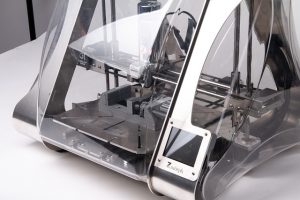
3D printing is a form of additive manufacturing that involves the use of a machine, known as a 3D printer, to build objects using raw material. 3D printers contain a nozzle through which raw material is extruded. The extruded material is released onto a print bed layer by layer, allowing for the construction of an object. While there different types of 3D printers, though, most of them require a similar method of operation that centers around three basic stages.
Stage #1) Preparation
The first stage of 3D printing is preparation. Also known as the pre-processing stage, it involves designing the object in a computer program as well as positioning and preparing the 3D printer itself. Before a 3D printer can build an object, the object must be designed in a computer program. Computer-aided design (CAD) programs allow manufacturing companies to build digital object models, which are then saved and transferred to a 3D printer for processing. Manufacturing companies design the object in a CAD program, after which they transfer the CAD file to a 3D printer. The preparation stage covers CAD design and other tasks associated with preparation.
Stage #2) Building
The second stage of 3D printing is building. During the building stage, the 3D printer will build the object. Most 3D printers build objects by extruding material out of a nozzle. The nozzle features a specific shape that allows the raw material to release in a uniform shape and consistency. As the material is extruded out of the nozzle, it’s deposited onto a print bed.
The building stage involves the complete production of the object. The 3D printer will move and extrude raw material according to the specifications of the CAD file with which it’s used. Building covers the production of an object as the 3D printer extrudes material out of a nozzle and onto a print bed.
Stage #3) Finishing
The third and final stage of 3D printing is finishing. Depending on the specific type of 3D printer used, as well as the object itself, the finishing stage may require the removal of supports. Objects are often constructed with supports so that they don’t collapse. After the object has been built, these structures must be removed.
Finishing may also involve the refinement of the printed object’s surface. If the printed object has a rough or otherwise grainy surface, it may be further processed to achieve a smoother surface. The finishing stage encompasses all post-production touchups such as this.
